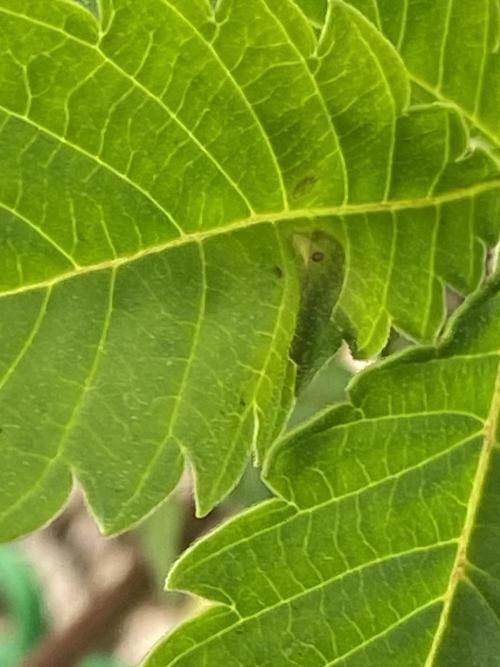The Grow Awards 2026 🏆 


























Black/Brown Dots
beetyjoocestarted grow question 3y ago
Hey squad,
Back again with another question lol.
Any idea what's going on with these black/brown dots? I also noticed some slight yellowing.
I've tried looking for a solution but I can't find an answer.
Thanks!
Open
Leaves. Color - Mottling
likes
Answer
Ultravioletanswered grow question 3y ago
Nutrients are classified as either immobile or mobile depending on if it can be moved around the plant once it’s been fully absorbed. Mobile nutrients are stored in older leaves and can be moved around the plant wherever it’s needed. Immobile nutrients stay close to where they were originally deposited.
Deficiencies & excess of mobile nutrients will appear in older growth and leaves first. Where as, deficiencies & excess of immobile nutrients will appear in new growth first usually at the top of the plant. Once you understand the difference and which nutrients are mobile and immobile, it makes it easier to diagnose & fix deficiencies.
Whenever you suspect a deficiency, always check your pH first and ensure that it is in the correct range. If it isn’t within the correct range, it won’t be able to absorb some nutrients. So, you could be treating a deficiency, but if the pH is off, it won’t be able to absorb the nutrient still. If your pH is in the correct range, you can now try to figure out what’s going on.
NPK the big 3 (& magnesium) are all mobile nutrients so the plant can take nutrients from old growth and use it for new growth if there is a deficency.
Since growth is only affected up top it tells us it's an immobile nutrient.
Does look like potassium but it would be all over if it was.
It is crucial for cell integrity and growth. Calcium helps with the flow of nitrogen and sugars throughout the plant. Deficiency usually happens with hydroponics or outdoors in very wet, cool conditions with acidic soil. First sign is distortion and curling of lower leaves. This is followed by irregular yellow-brownish spots with brown borders that grow over time. Finally, root tips will wither and die resulting in a stunted plant with low yields.
1 like
Complain
Paul_onanswered grow question 3y ago
Looks deficient phosphorus or potassium? Plants can get these problems nearer the end of flower, try flushing and giving a low dose of NPK plus a compost tea, or biosys microbe tea, usually works , hope it helps, happy growing ✌️🌱
1 like
Complain
AsNoriuanswered grow question 3y ago
Just calcium lockout because of too high N feeding ...
Or ph issue, not in range, usually too low if leaves goes to yellow and has rusty spots ..
Some people grow rot, do mistakes and offer wrong ways ...
If you in soil - never flush to sort problems !
1 like
Complain
ClydeGrowsanswered grow question 3y ago
Usually if there's not a clear answer looking at leaves, it's pH or watering issue in my experience. Doesn't hurt to do a little flush and see how she responds!
1 like
Complain
Similar Grow Questions
Solved

Doraemon
Weird color and strains on leavesToday my plants got something weird on their leaves. Some stains appeared on older leaves, and the new ones have a strange color, it looks like they are painted. More or less the same on another plant, some edges on new leaves look burned and weird color and shape on new leaves
Week 3
Leaves. Color - Mottling
6y ago
3
7
Solved
Rammer
What is it? Odd patches on leaves.I have notice an odd discoloring on a couple of fan leaves on a couple of my plants. Not really sure what to make of it.
Leaves. Color - Mottling
5y ago
4
4
Solved

SevenStoned
Why is she splotchy?What's wrong with my girl? Her leaves are splotchy. Is this light burn?
Week 4
Leaves. Color - Mottling
5y ago
4
3
Solved

stuffyloir
Macchia chiara/scura su di una fogliaHo trovato questa macchia su di una foglia, qualcuno saprebbe dirmi di cosa si trata? :)
Week 4
Leaves. Color - Mottling
1mo ago
6
5
Solved

Jamsey23
Help Identifying Ailment! BlackBerry Auto on week 6! Nutrient deficiency? Cant find anything online similar.This is my second grow since switching to hydro. Growth has slowed a lot. Leaves are getting brown spots and almost look like they're being eaten but no pests can be found. No root rot, I dont think I'm over watering them. Since I started hydro it's been a real challenge.
Leaves. Color - Mottling
Leaves. Other
2y ago
1
1
Solved

DrGreenThumb24
Potassium?Got a bit of an issue starting to show up on some leaves. Only on one plant.Could it be potassium?
Week 6
Leaves. Color - Mottling
3y ago
1
3
Solved

BudmanFlyingjoint
what's going on?
First photo was on 21/3/2024, 2nd on 25/3/2024, 3rd on 26/3/2024 Leaf kind of necrosis. New sprouts under fan leafs show green and yellow both bright.
Leaves. Color - Pale
Leaves. Color - Dark-purple
Leaves. Color - Mottling
2y ago
2
Solved

HydrokronicZA
Nutrient deficiency or surplus?Hi Guys will post a pic shortly. Have to update the grow as we are actually heading into week 6. One of the white widows is a fair bit smaller than the other. And is showing some form of difficiency or nutrient burn. I think it may be due to to little phosphorus. Opinions?
6y ago
4
3
Solved

BigBadLion
I'd like to know what happened to my plant but I'm unsure how to properly describe it. The photos in my diary should be able to make it more clean (W18). Maybe it was botrytis but I caught it on time? Or maybe something else? The trichomes got dark orange where all this happened!Week 18
Leaves. Color - Mottling
6y ago
3
5
Solved

Mabaluc
Leaves have some spotsMy auto flower has started presenting some spots, it's on week 3. But I've seen these marks since the beginning of week 2, been measuring my ph and everything looks fine. Maybe the super soil is a bit too strong, and it has to get used to it? The lamp is 27 inches away.
Leaves. Color - Mottling
5y ago
1
1
Solved

Aleatoric
Sick plant, could be temp, nutes, too much water?Leaf tips looking burnt and wilting in flower ... keeps getting worse no matter what. pH 6.8. Raised light. Too many nutes? but a couple days with water only and it's still getting worse. The other plant seems fine. The buds seem OK. Maybe heat? Soil is 69F. Overwater?
Leaves. Tips - Burnt
Leaves. Curl down
Leaves. Color - Mottling
2y ago
1
1
Solved

RastaMouse
Opinions needed.I have found what Might be calcium deficiency on one leaf near the top of one of my bush’s. but the rest of the bush looks super happy. Could it be light burn?? I feed them cal/mag so I m struggling to believe it could be calcium deficiency.
Week 8
Leaves. Color - Mottling
6y ago
10
5
Solved

Cali_Grown_420
Calcium Deficiency Won’t Go Away DWCSo plant #1 is still having some Calcium deficiency issues. I’m using RO water and giving the recommended dose of CaliMagic which is 1tsp(5ml)/gal. I’m in DWC and using LED full spectrum lighting. Why can’t I stop these spots? Should I give more than recommended dose of CaliMagic
5y ago
6
5
Solved

Reefer_Chiefer1024
What kind of deficiency?Is this a magnesium deficiency or something else?
Week 6
Leaves. Color - Mottling
4y ago
2
2














